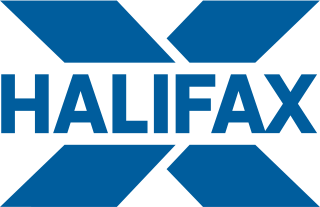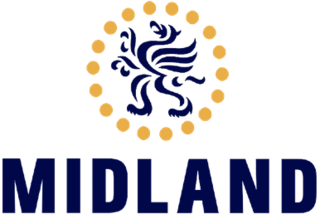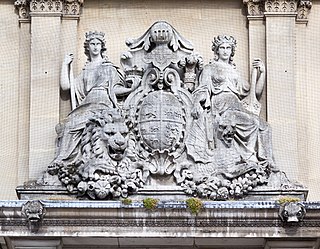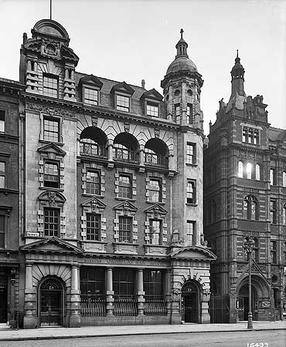
Halifax is a British banking brand operating as a trading division of Bank of Scotland, itself a wholly owned subsidiary of Lloyds Banking Group.

Royal Bank of Canada is a Canadian multinational financial services company and the largest bank in Canada by market capitalization. The bank serves over 17 million clients and has more than 89,000 employees worldwide. Founded in 1864 in Halifax, Nova Scotia, it maintains a corporate headquarters in Toronto and its head office in Montreal. RBC's institution number is 003. In November 2017, RBC was added to the Financial Stability Board's list of global systemically important banks.

Lloyds Bank plc is a British retail and commercial bank with branches across England and Wales. It has traditionally been considered one of the "Big Four" clearing banks. Lloyds Bank is the largest retail bank in Britain, and has an extensive network of branches and ATMs in England and Wales and offers 24-hour telephone and online banking services. As of 2012 it had 16 million personal customers and small business accounts.

Danske Bank A/S is a Danish multinational banking and financial services corporation. Headquartered in Copenhagen, it is the largest bank in Denmark and a major retail bank in the northern European region with over 5 million retail customers. Danske Bank was number 454 on the Fortune Global 500 list for 2011. The largest shareholder is A.P. Moller Holding connected to the Maersk family.

Ulster Bank is a large retail bank, and one of the traditional Big Four Irish clearing banks. The Ulster Bank Group is subdivided into two separate legal entities: National Westminster Bank PLC, trading as Ulster Bank ; and Ulster Bank Ireland DAC. The headquarters of Ulster Bank in the Republic of Ireland are located on George's Quay, Dublin, whilst the headquarters of Ulster Bank Northern Ireland are in Donegall Square East, Belfast, and it maintains a large sector of the financial services in both the UK and the Republic of Ireland.

Permanent TSB Group Holdings plc, formerly Irish Life and Permanent plc is a provider of personal financial services in Ireland. Irish Life Assurance plc and the Irish Permanent Building Society merged to form the Irish Life and Permanent Group in 1999 and the merged entity acquired the Trustee Savings Bank in 2001. The group has no connection to the UK's TSB Bank.

HSBC Bank Malta plc is the Maltese subsidiary of the British multinational banking and financial services company HSBC. The company is headquartered in Qormi and operates over 30 branches and offices throughout the islands of Malta and Gozo. HSBC Bank Malta is part of the European region within HSBC and therefore reports to HSBC Bank plc.

Midland Bank Plc was one of the Big Four banking groups in the United Kingdom for most of the 20th century. It is now part of HSBC. The bank was founded as the Birmingham and Midland Bank in Union Street, Birmingham, England in August 1836. It expanded in the Midlands, absorbing many local banks, and merged with the Central Bank of London Ltd. in 1891, becoming the London City and Midland Bank.

Marine Midland Bank was an American bank formerly headquartered in Buffalo, New York, with several hundred branches throughout the state of New York. In 1998, branches extended to Pennsylvania. It was acquired by HSBC in 1980, and changed its name to HSBC Bank USA in 1999. As a result of several transactions since the turn of the millennium, much of what was once Marine Midland is now part of KeyBank with the exception of Downstate New York and Pennsylvania. that is now part of Citizens Bank. Branches in Seattle are part of Cathay Bank.

National Provincial Bank was a British retail bank which operated in England and Wales from 1833 until 1970 when it was merged into the National Westminster Bank. It continued to exist as a dormant non-trading company until 2016 when it was voluntarily struck off the register and dissolved.

Westminster Bank was a British retail bank which operated in England and Wales from 1834 until its merger into the National Westminster Bank in 1970; it continued to exist as a dormant registered non-trading company until 4 July 2017 when it was dissolved. Considered one of the Big Five, it expanded during the nineteenth and twentieth centuries and took over a number of smaller banking companies.

Canara Bank is an Indian public sector bank under the control and ownership of Ministry of Finance, Government of India. Established in 1906 at Mangalore by Ammembal Subba Rao Pai, the bank also has offices in London, Dubai and New York.
Banknotes have been issued for use specifically in Northern Ireland since 1929, and are denominated in pounds sterling. They are legal currency, but technically not legal tender anywhere. This is not uncommon as most bank notes are not recognised as tender. However, the banknotes are still widely accepted as currency by larger merchants and institutions elsewhere in the United Kingdom. Issuing banks have been granted legal rights to issue currency, and back the notes with deposits at the Bank of England.

The historic overseas bank was established in London in 1828 as Leslie & Grindlay, agents and bankers to the British army and business community in India. Banking operations expanded to include the Indian subcontinent, the Middle East and elements of Africa and Southeast Asia. It was styled Grindlay, Christian & Matthews in 1839, Grindlay & Co from 1843, Grindlay & Co Ltd from 1924 and Grindlays Bank Ltd in 1947 until its merger with the National Bank of India.
National Westminster Bank, commonly known as NatWest, is a major retail and commercial bank in the United Kingdom based in London, England. It was established in 1968 by the merger of National Provincial Bank and Westminster Bank. In 2000, it became part of The Royal Bank of Scotland Group, which was re-named NatWest Group in 2020. Following ringfencing of the group's core domestic business, the bank became a direct subsidiary of NatWest Holdings; NatWest Markets comprises the non-ringfenced investment banking arm. The British government currently owns around 48.1%, previously 54.7% of NatWest Group after spending £45 billion bailing out the lender in 2008. NatWest International is a trading name of RBS International, which also sits outside the ringfence.
The National Commercial Bank of Scotland Ltd. was a Scottish commercial bank. It was established in 1959 through a merger of the National Bank of Scotland with the Commercial Bank of Scotland. Ten years later it merged with the Royal Bank of Scotland, to become the largest clearing bank in Scotland. The National Commercial Bank issued its own banknotes.

Northern Bank Limited T/A Danske Bank is a retail bank in Northern Ireland. Northern Bank is one of the oldest banks in Ireland having been formed in 1809, and forms part of one of the Big Four banks in Ireland. Northern Bank took on the name of its parent company Danske Bank as its trading name in November 2012. It is a leading bank in Northern Ireland and a growing bank in Great Britain. In Northern Ireland the Bank issues its own banknotes.
William Tennant (1759–1832), often spelled William Tennent, was an Ulster Presbyterian banker and a leading member in Belfast of the Society of the United Irishmen who, in 1798, sought by insurrection to secure a representative and independent government for Ireland. After a period of imprisonment he returned to the commercial and civic of Belfast, in 1810 helping to found what is today the Royal Belfast Academical Institution.

The Assembly Rooms is a Grade B1 listed building in Belfast, Northern Ireland. It was built, as the single-storey Exchange, in 1769 by Arthur Chichester, 1st Marquess of Donegall. The Marquess expanded to a second floor in 1776 and the building came to be known by its current name. It housed the Belfast Harp Festival of 1792, public meetings and, following the Irish Rebellion of 1798, the court martial of rebel leaders. The building was converted into a branch of the Belfast Banking Company in 1845. It was extended several times and received listed building protection in 1975. The bank, now part of Northern Bank, vacated the building in 2000. Since then the structure has only been occasionally used and has been subject to vandalism. It is on the Northern Ireland Buildings at Risk Register.

















